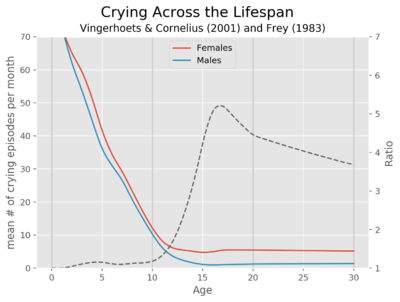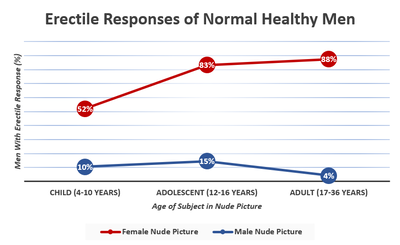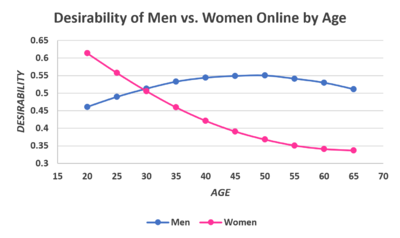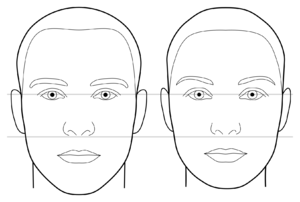Neoteny

Neoteny or pedomorphism refers to an adult organism retaining juvenile features, in humans, this means a roundish, soft face with large eyes, short nose, full lips and clear skin, but also overall a shorter and weaker stature. Neoteny is a highly desirable trait in women and women are more neotenous than men in appearance, mentality and behavior (e.g. adult crying). Women use fakeup to enhance their neoteny by smoothing their skin and enhancing eye contrast.[1] Compared to other mammals, humans are overall more neotenous as evidenced by their lack of fur, small teeth, smooth skin and large eyes,[2] presumably as a result of self-domestication and K-selection. As a result, a fairly high amount of neoteny is normal, and to some extent even attractive in men (but presumably only as long it is not an outright feminine appearance regarding chin, nose and eye region). Other K-selected, highly (eu-)social higher animals such as the naked mole-rat are also found to exhibit neotenous features such as nakedness, slow maturation and a high life expectancy.[3]
In men, neoteny can be exaggerated through feminization, resulting in pubefantilism (delayed puberty) and a feminized phenotype which may negatively affect dating prospects (cutecel),[4] partly due to a diminished capacity to intimidate other males.[5] A woman with very neotenous features is referred to as a fauxbait.
Women's neoteny steeply declines in their twenties such that women's rate of aging is faster than men's, which is known as hitting the wall.[6] A twenty-five year old woman will already have a less neotenous facial fat distribution and hence appear less sexually attractive than an eighteen year old woman, but this effect is attenuated by the great oversupply of sexually frustrated men. Men's preference for youthful women can be seen in men's re-marriage patterns: The age gap is three years at first marriage, five years at second marriage, and eight years at third marriage.[7]
Sex differences in neoteny[edit | edit source]
With regards to overall sexual dimorphism in great apes and other mammals, one can distinguish tournament and pair-bonding species. In tournament species, the males are much larger and stronger than the females and the males compete violently (in "tournaments") with a high rate of polygyny and the alpha male violently defending his harem. Contrasting this, sexual dimorphism is much smaller in pair-bonding species where the males are less violent, invest more in the offspring due to bonding in pairs (monogamously) and where the species is overall more K-selected. Humans are regarded to be somewhere in between with a moderate amount of polygyny and accordingly humans only have moderate sexual dimorphism.[8] On the other hand, the amount of resources men provide relative to women is quite extreme compared to most animals and unique among primates, with men providing twice as much calories in hunter-gatherers than women and exclusively providing the more nutrient dense meat from hunting which men used to get mating opportunities and invest into offspring and their mate ever since.[9][10][11] For this reason, humans occupy a special position with regards to the tournament/pair-bonding spectrum, with men defending their harem through wealth rather than violence,[12] and with women advertising their sexual dimorphism and neoteny to get access to resources.[13] Also, despite only moderate differences in overall body size, men's and women's appearances are still so distinct that humans can categorize faces by sex with 98% accuracy.[14] When relying just on the facial geometry (without skin tone/texture), this drops to 75%.[14] It should be noted that sexual dimorphism may overall be somewhat reduced in industrialized countries due to high mutational load in the gene pool (primarily owing to very low child mortality), and/or due to pollutants and toxins (see also feminization).
Body[edit | edit source]
The most obvious physical neotenous trait in women is their shorter stature. Even though men are only about 8% taller on average, this sex difference has a very large effect size of d = 2.0,[15] meaning most men are taller than most women. Accordingly, women also have a weaker physique, especially a weaker upper body and thinner arms leading to large sex differences in lifting, grip strength and especially in throwing with effect sizes of d = 2.5 to 3.0.[16]
An important pedomorphic feature at the gestalt level of the body is the head size relative to the entire body. Women's and men's heads are, however, roughly proportional to their stature without noteworthy sex differences in this ratio.[17][15] Though, women's ratio of head to body size is higher when including their fuller, longer hair and more voluminous hair styles,[18] as well as when rather relating women's head to their 11% (d = 1.6) narrower shoulder width and narrower neck. The ratio of maximal cranial width to shoulder is significantly, but only slightly different (0.37 vs 0.39),[19] but that excludes women's thinner arms and about 50% more voluminous hair.[20] Women's hair is more voluminous due to each hair strand growing for a longer duration (not faster) before it falls out.[21] Another very noticeable overall neotenous feature is women's body and facial hair having a lower density and thickness.[22] Women have a variety of less visible neotenous traits such as a more delicate skeleton, smaller mastoid processes, smoother ligament attachments, lower basal metabolism, larger tear ducts, faster heartbeat and greater longevity.[22]
Face[edit | edit source]
A neotenous face is marked by a high ratio of neurocranial to lower-facial features, while also exhibiting a small nose and ears and full lips.[23] Women's upper-to-lower-facial-height ratio is 1.23 while men's is 1.07.[14] Baby's eyes are large relative to their overall body size, but while it is true, that men are more sexually attracted to women with larger eyes,[24] women's eyes are not actually larger than men's in absolute terms. Among Caucasians aged 20 to 40, men's eyes are actually slightly wider than women's eyes (28.7±1.9 mm vs 27.7±2 mm).[25][26] There is also no significant sex difference in exposed iris as a fraction of the overall eye area.[27] However, due to women's smaller mandible and nose, women's eyes appear proportionally slightly larger than men's.[28] Women's nose is on average around 12% less deep and wide than men's with a very large effect size of about d = 2,[29][30] but notably women's nasal height is only 3% shorter.[31] Since human perception only estimates sizes relative to the context, not absolute sizes, larger eyes have presumably the same effect on men's sexual attraction as proportionally smaller noses and lower-facial features. Women's teeth are slightly smaller, however, this difference is so small that even dentists cannot tell the difference.[32][33] Women's teeth tend to be more quadrangular, which may be a neotenous tooth shape,[34][35] while men's teeth are a bit more often triangular, resembling more canine teeth and the teeth of closely related pan, which may hence be a geronomorphic trait.
A more substantial sex difference than eye size is that women's eyes are rounder (d = .66 in terms of width-to-height ratio, which is a moderate effect size), while men's eyes tend to be vertically narrower and the corners of the eyes are more rectangular like hunter eyes.[27] This might also make women's eyes appear larger. Another very noticeable sex difference in facial morphology is women's higher, thinner and fainter eyebrows,[36] which also appears to be pedomorphic and might highlight the eyes. This sex difference may stem from men's hunter eyes which are framed by more pronounced brow ridges which possibly have the purpose of protecting the eyes from sticks and claws during hunting.[37] The higher eyebrows may also enable women to put on a more effective pouting/frowning expression. While men's forehead is slightly concave due to the brow ridge like it is found in apes, women's forehead is more smooth and round like that of children.[22][38]
Women's less developed lower-facial features are primarily evidenced by their lower facial depth being about 10% shorter than men's (d = 2.0),[39] i.e. a lower distance from the chin to the ears and less forward growth, owing to a shorter mandible, which is also narrower (d = 1.0).[40] Women's upper and lower lips are about 10% fuller/higher on average (d = 1.0 for the upper lip and d = 0.7 for the lower lip).[41] Women also have a more subcutaneous fat in their faces and their entire bodies.[42] Women are more babyfaced due to these fat deposits and their more developed buccinator muscles, which also contributes to making their faces appear rounder. These muscles being more developed in women has been suggested to be explained by women's greater propensity to smile.[14] Smiling is a pedomorphic trait as well with children smiling 20 times as often as adults.[43] The large difference in accuracy classifying faces by sex between textured and non-textured faces (as mentioned introductorily), suggests a substantial facial sexual dimorphism lies in facial texture which likely primarily owes to women's lack of facial hair, thinner skin and reduced creases due to their subcutaneous fat deposits; once again neotenous features.[44] Another trait concerning the facial texture is women's higher facial contrast,[45] and facial contrast has been linked to perceived age, with a high facial contrast being a pedomorphic trait, potentially explaining why women use powder, eyeliners and lipstick to trick men into believing they are young and fertile,[1] in addition to powder smoothing the skin texture, making it appear like that of children.
Behavior[edit | edit source]

In accordance with women's physical neoteny, women are also behaviorally, mentally, psychologically and neurologically more neotenous. Women's central nervous system has younger characteristics,[46] women's brains are about 11% smaller than men's,[47] and women's average IQ is slightly lower compared to men's.[48]
A very noticeable neotenous behavior in women is their higher rate of crying. Women cry on average about four times as often as men's, which matches the rate of 11 year old boys. About 54% of men cry very rarely, but only 18% of women (about d = 1).[49] Women also score about one standard deviation higher in questionnaires measuring emotional instability (neuroticism) which can be regarded as a neotenous trait as children are less patient, more fickle, nagging, complaining, protesting, tend to have tantrums and emotional meltdowns. These behaviors boil down to a need for attention to ensure access to social comfort, food, or other basic needs. Accordingly, women are diagnosed with mood disorders, borderline personality disorder, anxiety and depression more often than are men.[50] Women's need for constant attention can also seen in their habits of posting selfies online,[51] though this is partly motivated by resource acquisition through self-sexualization.[52]
Similar to children, women have greater fear of crime, darkness and loneliness,[53] as well as a higher incidence of nightmares (among young women at least).[54] This research is self-report based and may be biased by men acting tough, but that in itself may be a gerontomorphism.[55] 53% of women said they are scared to be in the house alone compared to 25% of men (d = .75).[56] Just like children, women more often exhibit bedtime procrastination, i.e. a reluctance to go to sleep, compared to adults/men.[57]
Playfulness, curiosity, imagination are central to childish behavior, and indeed women are, for example, more interested in fictive stories compared to men,[58][59] and more interested in simple creative hobbies like knitting,[60] diary writing,[61] and more often report dreaming/daydreaming.[62] In personality questionnaires, women more often report to like flowers (d = 0.81) and dance performances (d = 0.71) when compared to men.[63] However, only women's interpersonal curiosity is higher than men's, while men exhibit more curiosity about things.[64] Moreover, play drive, teasing, mischievousness etc. are generally inhibited in women due to a generally lower activity level, and a more private, inward, domestic orientation, so men are actually more childish regarding daredevil, thrill-seeking, risk-taking interests and undertakings such as skydiving, racing, confrontation and provocation. However, risky behavior is frequently rather driven by gerontomorphic status drive than by paedomorphic play drive. These sex differences in temperament (greater inhibitory control in girls and greater activity and rough-and-tumble play in boys) already emerge before puberty, i.e. before women arrest in their development in a more neotenous state.[65] Women do show more neotenous excitement, impulsiveness, expression of joy, dancing/singing/bouncing,[66] unpredictability, facial expressiveness (both positive and negative expression),[67][68][69] women and children giggle and smile more than men,[70] but again more confined to the private and with less energy.
Women score higher in agreeableness, compliance and withdrawal, which remind of subordinating behavior observed in children. Compliance is furthermore related to picking up on other's emotions. As an example, women are ten times as likely as men to get infected by mass hysteria,[71] and are more likely to cry when receiving criticism (which might suggest they are picking up on the negative atmosphere in the room).[72] In some studies, women nonconsciously mimic facial expressions more than do men, but there are mixed finding regarding this sex difference.[73] Women also display more trust, conformity, are more forgiving (apologize more),[74] have more trust in authority figures, desire to please others, prefer structure and rules, seek reassurance etc. For example, women are more in favor of norm enforcement that restricts freedom of speech.[75] Similarly, children prefer aggressive norm enforcers over laissez-faire types.[76] Women and children generally share a behavioral tendency to expect men (and parents) to do things for them,[77] and to live in their own solipsistic world, devoid of responsibility.
Other neotenous behaviors are immaturity, honest observations and lack of social filters, which may partly result from the lack of responsibility. Women and children maintain fewer close friendships compared to men/adults,[78] and female groups frequently engage in childish gossip, frequently as a form of intrasexual competition.[79] Women are more strongly influenced by task-irrelevant spatial information than men (d = 0.39) which reminds of short attention spans in children,[80] though this may also be a result of women's lower spatial abilities. Both women and children score lower in cognitive reflection tests that measure the ability to inhibit one's intuitive response to engage in reflection.[81][82]
A neotenous trait in between physical and behavioral features is pitch and loudness of voice, as this is partly determined by the chest size acting as resonating body. Women's voice has a substantially higher fundamental frequency, remaining at the vocal pitch of prepubescent boys, with sex differences around d = 5 among young adults,[83][84] making the voice one of the most conspicuous and distinguishing sexual characteristic.
The existence of a sex difference in neotenous behavior in human adults does not mean that all women are more childlish than all men, but just that women are strongly overrepresented among adults exhibiting extreme degrees of childishness, while those who are exceptionally rational and mature are almost exclusively male.
Culture[edit | edit source]
Sex differences in neoteny are reflected in various cultural adaptations as women are treated more like children than like adults. People more often use infantilizing language, diminutives like 'girl', 'baby', or 'sweetie' as form of address or term of endearment for women, while 'boy' or 'baby' is less common when referring to men,[85] and 'boy' doesn't have a diminutive connotation as 'girl'.[86] Like children, women are rescued first (Birkenhead drill), are held to lower standards and expectations, have restricted societal roles, decision making and responsibility, are restricted to domestic confines, are more protected, economically dependent and their opinions are more readily dismissed.[87] Women and children are assumed to be more innocent (see e.g. women-are-wonderful effect), though in case of women this has an additional sexual component due to the overall preference for paternity assurance and STD prevention.
Sexual attraction to neoteny[edit | edit source]


While femininity is unattractive in men, it is considered highly attractive in women.[4] Cross-culturally, men prefer women with larger eyes and smaller noses,[24] and smaller lower-facial features compared to the upper half of the face.[23] Further, healthy men exhibit a significant involuntary penile arousal in response to visual stimuli of even prepubescent human females (in half of men), with girls aged 12-16 eliciting just as much penile arousal in men as adult women.[88] Highly attractive Italian models in exhibited more babyness with regards to their soft-tissue facial characteristics.[89] There is mixed evidence on more neotenous/feminine looking women to have a higher reproductive success in modern industrialized nations.[90] Women with longer i.e. more voluminous hair are rated as more physically attractive,[91] possibly because it mimics a pedomorphic head-to-body ratio. Men are sexually attracted to high pitched feminine voices and a high pitch is a reliable signal of youth.[92]
With regards to women's psychological neoteny, there is less evidence for men finding it outright sexually attractive when compared to men's attraction to women's physical neotenous features. In one study, neurotic women had slightly higher reproductive success, however this result was only significant at p < 0.05.[93] Another study found that men are indeed drawn to women on the borderline spectrum, but only if they are physically attractive.[94]
The potential existence for a genetic foundation of men's attraction to underage girls, of course, does not justify acting upon these urges, but it hints at the possibility that one cannot simply change men's sexual preference, nor that they are an acquired 'addiction'.
Evolution of female neoteny[edit | edit source]
An explanation for men's mate preferences for youthfulness (and as a result women being selected for retaining their youthfulness) may be that women have a costlier and shorter reproductive life. While men's sperm motility, count and shape only decreases by about 50% after the age of 50, women become entirely infertile by around 45-55. Women's maternal mortality rate also quadruples by age 40.[95] The younger the woman a man chooses to invest into and reproduce with, the higher the reproductive success he can expect with her, explaining why men with a preference for fertile and young women were selected for by evolution. Investing in an old woman would be a waste of a man's resources with respect to his reproductive success.[96]
Another line of theories about women's neoteny concerns their resource-dependence on men. Due to sex differences in parental investment, women evolved to be coy and choosy, and men evolved to be taller and stronger than women in an evolutionary arms race among men competing for reproductive opportunities. As a result, women became dependent on men's resources.[97] Due to women's resource-dependence, it is possible that they retain child-like features such that males are encouraged to invest into them much like humans of either sex invest more in cute looking offspring (baby schema).[98][99][100][13][101] Men's attraction to neotenous females may hence be explained by both encouraging men's investment in their wives (and hence the offspring), as well as by enabling higher survival rates of cute looking female offspring, with the female offspring being more dependent on surviving by mere cuteness than the males (especially at post-pubertal age). This may possibly even give rise to a feedback loop in men's sexual attraction to neoteny.[102] Neoteny serves the same purpose of encouraging parental investment in other animals,[99] and neoteny also provokes play drive, sometimes to the extent of causing playful aggression.[103] Due to the relatedness of species, the signaling also works across different species, leading e.g. humans to breed cute looking pets that they take pleasure in providing for.
Men's non-neoteny compared to women can also be explained by differential parental investment, as gerontomorphic/peramorphic, apish traits may be retained due to men's more violent forms of intrasexual competition, but such traits may also severe the mere intimidation in intrasexual competition.[13] Human males have likely simultaneously been selected for neoteny by society as a result of self-domestication, as they are, too, much more neotenous than most great apes.
Interestingly, women’s preferences for men’s facial neoteny (rather than masculinity) appear to be strongest under disfavorable ecological conditions,[104] which may result from similar evolved mate preferences that ensure higher survival rates through cute looking offspring (which is related to Travis-Willard hypothesis, which states that the sex ratio at birth skews female under harsh conditions due to women having a higher survival rate). Though there is also evidence to the contrary that neoteny is less preferred in case of environmental threat.[105]
Another hypothesis for the evolution of female neoteny may be that it has been sexually selected for by males in efforts of ensuring paternity. Different from men, women can always be certain their offspring is their own. As a result, men may have evolved to desire certainty about their paternity. Moreover, being providers of resources, men have extra incentive to minimize the chances of investing in someone else's offspring. Men can best achieve this certainty by monopolizing girls as early as possible, preventing other men from impregnating them. Further, men may have evolved to prefer childish, weak, submissive and obedient women, as those are easy to control. Gowaty (1992) writes:
There should be strong selection on males to control females' reproduction through direct coercive control of females […]. Evolutionary thinkers, whether informed by feminist ideas or not, are not surprised by one of the overwhelming facts of patriarchal cultures, namely that men […] seek to constrain and control the reproductive capacities of women […]. Juvenilization decreases the threat some men may feel when confronted with women; many men are comfortable around women whom they can clearly dominate and are profoundly uncomfortable around women whom they cannot so clearly dominate.[106]
An alternative or additional explanation for men's attraction to female youth may be that women lose their fertility sooner. An older man can still reproduce with a substantially younger woman and does not depend on her ability to protect, whereas women do depend on a protective partner. Women's fertility peaks in their mid twenties, and a clear skin and full lips are signals of youth which women accordingly get selected for as men will perceive women without those features to be older, and judge them to be infertile sooner, reducing their reproductive success. This alone is an insufficient explanation, however, because young boys prefer girls of their own age who do not have maximal fertility.[107]
Adaptions for female neoteny may explain male hebephilia, i.e. the sexual interest in pubescent girls which may affect most men,[108] and, as extreme instantiation of these adaptations, it may also explain pedophilia, i.e. the sexual interest in prepubescent girls. In fact, children's smooth skin and innocence may act as a super stimulus on men's sexual preferences for neoteny. This may also point to female neoteny being a Fisherian adapation.[102]
Men's selection for paternity assurance may even have reduced women's spatial abilities as men would prefer women who are scared of getting lost, rather than ones who are nimble at navigating their ways to different men. It may also explain women's stronger same-sex attraction as men would have preferred their harem women to derive additional sexual pleasure from each other rather than from other men.[109] Another explanation may be that signals of childishness and helplessness acted as a means of ensuring continued investment on part of males, thus females with neotenous behavior such as crying had a better chance of accruing resources for their offspring and thus increasing their survival.
Artificial juvenilization[edit | edit source]
Artificial attempts at achieving a neotenous look is called juvenilism or adolescentilism wherein people (especially women) attempt to look like adolescents and more childlike often by means of fakeup, even when they are actually vicenarian or tricenarian, … or maybe even older.
East Asians[edit | edit source]
Hominids tended to become more neotenous as they evolved (e.g larger skulls, smaller jaws, less body and facial hair). Humans are more similar in physical appearance to infant chimpanzees as compared to adult chimpanzees because of humans greater levels of neoteny. So the East Asian race (which is the furthest evolved from the African prototype) has the most neoteny.[110] Since women prefer dominant looking men, this gives the less neotenous looking Caucasian males dating advantages over East Asian men. This may explain the SEAmaxxing phenomenon, alongside the alternative explanation that Asian women associate Caucasian males with prosperity and wealth (hypergamy). Conversely, East Asians women may be particularly attractive to men of European descent, possibly explaining the keen interest of some in Asian women and the relatively high outmarriage rates of Asian women in Western countries (AFWM).
Cutecels[edit | edit source]
Cutecels are men whose inceldom can be attributed to their neotenous appearance.
See also[edit | edit source]
- Kawaii
- Aegyo
- Canthal tilt
- Fake depression
- Female sneakiness
- Female solipsism
- List of aesthetics
- Feminization
- Beauty
- Pretty Boy
- Loli
References[edit | edit source]
- ↑ 1.0 1.1 https://www.frontiersin.org/articles/10.3389/fpsyg.2017.01208/full
- ↑ https://en.wikipedia.org/wiki/Neoteny
- ↑ https://journals.physiology.org/doi/full/10.1152/physrev.00040.2015?view=long&pmid=28202600
- ↑ 4.0 4.1 https://www.sciencedirect.com/science/article/abs/pii/0092656678900740
- ↑ https://incels.wiki/w/Scientific_Blackpill#Among_male_university_students.2C_only_cues_of_physical_dominance_over_other_men_predicted_their_mating_success
- ↑ https://onlinelibrary.wiley.com/doi/full/10.1002/ajpa.23878
- ↑ Buss, 1994/2003
- ↑ https://openlibrary.org/books/OL26423129M/Behave
- ↑ https://www.sciencedirect.com/science/article/pii/S016748701630277X
- ↑ https://www.sciencedirect.com/science/article/abs/pii/S1090513810000279
- ↑ https://incels.wiki/w/Scientific_Blackpill_(Supplemental)#In_hunter-gatherers.2C_men_use_meat_to_obtain_mating_opportunities_and_to_invest_in_mates_and_offspring
- ↑ https://www.jstor.org/stable/3565861
- ↑ 13.0 13.1 13.2 https://www.sciencedirect.com/science/article/abs/pii/S1090513810000279
- ↑ 14.0 14.1 14.2 14.3 Tanikawa, C., Zere, E., & Takada, K. (2016). Sexual dimorphism in the facial morphology of adult humans: A three-dimensional analysis. HOMO - Journal of Comparative Human Biology, 67(1), 23–49. doi:10.1016/j.jchb.2015.10.001
- ↑ 15.0 15.1 https://en.wikipedia.org/wiki/Average_human_height_by_country Using Finns as reference population for Caucasians
- ↑ https://incels.wiki/w/Scientific_Blackpill_(Supplemental)#Almost_all_men_are_stronger_than_almost_all_women
- ↑ https://www.facebase.org/facial_norms/summary/#maxcranwidth
- ↑ Mesko, N., & Bereczkei, T. (2004). Hairstyle as an adaptive means of displaying phenotypic quality. Human Nature, 15(3), 251–270. doi:10.1007/s12110-004-1008-6 (see "coverage hypothesis")
- ↑ A. Roberto Frisancho. (2008). Anthropometric Standards An Interactive Nutritional Reference of Body Size and Body Composition for Children and Adults. 2nd Edition
- ↑ https://www.sciencedirect.com/science/article/abs/pii/S095741741400709X
- ↑ https://books.google.com/books?id=CkUPCgAAQBAJ&pg=PA130&lpg=PA130&dq=anagen
- ↑ 22.0 22.1 22.2 Montagu A (1989). Growing Young (2nd ed.). Granby, MA: Bergin & Garvey Publishers. ISBN 978-0-89789-167-7.
- ↑ 23.0 23.1 https://digitalcommons.usu.edu/cgi/viewcontent.cgi?article=1601&context=fchd_facpub
- ↑ 24.0 24.1 Cunningham MR, Roberts AR, Barbee AP, Druen PB, Wu CH (1995). "Their ideas of beauty are, on the whole, the same as ours": consistency and variability in the cross-cultural perception of female physical attractiveness". Journal of Personality and Social Psychology. 68 (2): 261–79. doi:10.1037/0022-3514.68.2.261. S2CID 27778786.
- ↑ https://www.facebase.org/facial_norms/summary/index.html#palpfislength_r
- ↑ https://www.facebase.org/facial_norms/summary/index.html#palpfislength_l
- ↑ 27.0 27.1 https://link.springer.com/article/10.1007/s00265-020-02894-1
- ↑ https://www.facebase.org/facial_norms/summary/index.html#maxfacewidth
- ↑ https://www.facebase.org/facial_norms/summary/index.html#nasalalalength_r
- ↑ https://www.facebase.org/facial_norms/summary/index.html#nasalwidth
- ↑ https://www.facebase.org/facial_norms/summary/#nasalheight
- ↑ https://pubmed.ncbi.nlm.nih.gov/14696944/
- ↑ https://pubmed.ncbi.nlm.nih.gov/21547373/
- ↑ Brunetto, J., Becker, M. M., & Volpato, C. A. M. (2011). Gender differences in the form of maxillary central incisors analyzed using AutoCAD software. The Journal of Prosthetic Dentistry, 106(2), 95–101. doi:10.1016/s0022-3913(11)60102-9
- ↑ https://www.researchgate.net/figure/Dental-morphology-a-Quadrangular-tooth-b-oval-tooth-and-c-triangular-tooth-c-b-a_fig3_263708377
- ↑ Cartwright, M. J., Kurumety, U. R., Nelson, C. C., Frueh, B. R., & Musch, D. C. (1994). Measurements of Upper Eyelid and Eyebrow Dimensions in Healthy White Individuals. American Journal of Ophthalmology, 117(2), 231–234. doi:10.1016/s0002-9394(14)73081-8
- ↑ https://incels.wiki/w/Scientific_Blackpill_(Supplemental)#In_hunter-gatherers.2C_men_use_meat_to_obtain_mating_opportunities_and_to_invest_in_mates_and_offspring
- ↑ https://www.frontiersin.org/articles/10.3389/fpsyg.2018.00942/full
- ↑ https://www.facebase.org/facial_norms/summary/index.html#lowfacedepth_r
- ↑ https://www.facebase.org/facial_norms/summary/#mandwidth
- ↑ https://www.facebase.org/facial_norms/summary/#uplipheight
- ↑ Nedungadi, T. P., & Clegg, D. J. (2009). Sexual dimorphism in body fat distribution and risk for cardiovascular diseases. Journal of cardiovascular translational research, 2(3), 321-327.
- ↑ https://www.donsdaledental.com/kids-smile-way-more-than-adults/
- ↑ https://www.jstor.org/stable/41464142
- ↑ https://doi.org/10.1068%2Fp6331
- ↑ https://www.medpagetoday.com/neurology/generalneurology/77834
- ↑ https://www.sciencedaily.com/releases/2021/03/210325115316.htm
- ↑ https://incels.wiki/w/Scientific_Blackpill_(Supplemental)#Women_have_a_slightly_lower_average_IQ_which_drastically_reduces_their_intellectual_output
- ↑ https://incels.wiki/w/Scientific_Blackpill_(Supplemental)#Women_cry_four_times_as_much_as_men_and_never_outgrow_teenage_crying_behavior
- ↑ https://www.ncbi.nlm.nih.gov/pmc/articles/PMC4890708/
- ↑ https://www.researchgate.net/publication/353605508_Peer_phubbing_and_selfie_liking_The_roles_of_attention_seeking_and_gender
- ↑ https://www.pnas.org/doi/10.1073/pnas.1717959115
- ↑ https://en.m.wikipedia.org/wiki/Women%27s_fear_of_crime
- ↑ https://pubmed.ncbi.nlm.nih.gov/20817509/
- ↑ https://www.researchgate.net/profile/Robbie-Sutton/publication/31489318_Gender_Socially_Desirable_Responding_and_the_Fear_of_Crime_Are_Women_Really_More_Anxious_about_Crime/links/572a086b08aef7c7e2c4ee52/Gender-Socially-Desirable-Responding-and-the-Fear-of-Crime-Are-Women-Really-More-Anxious-about-Crime.pdf
- ↑ https://www.mirror.co.uk/news/weird-news/surprising-number-adults-still-scared-11520336
- ↑ https://pubmed.ncbi.nlm.nih.gov/31619947/
- ↑ https://incels.wiki/w/Scientific_Blackpill#Women_are_drawn_more_than_men_to_nonfiction_stories_of_rape.2C_murder.2C_and_serial_killers
- ↑ https://journals.sagepub.com/doi/abs/10.1177/0961000617709061
- ↑ https://www.tandfonline.com/doi/abs/10.1080/14759756.2017.1362748
- ↑ https://link.springer.com/content/pdf/10.3758/BF03334787.pdf
- ↑ https://pubmed.ncbi.nlm.nih.gov/478659/
- ↑ https://osf.io/tbmh5/
- ↑ https://pubmed.ncbi.nlm.nih.gov/478659/
- ↑ https://psycnet.apa.org/record/2006-00818-004
- ↑ https://www.researchgate.net/publication/292158875_MEN_AND_WOMEN_LIKE_TO_DANCE
- ↑ https://jeps.efpsa.org/articles/10.5334/jeps.de
- ↑ https://doi.org/10.1007/BF00988033
- ↑ https://doi.org/10.1037/h0033171
- ↑ https://psycnet.apa.org/record/1998-00031-026
- ↑ https://incels.wiki/w/Scientific_Blackpill_(Supplemental)#90.25_of_victims_of_workplace_mass_hysteria_are_women
- ↑ https://incels.wiki/w/Scientific_Blackpill_(Supplemental)#Women_cry_four_times_as_much_as_men_and_never_outgrow_teenage_crying_behavior
- ↑ https://jeps.efpsa.org/articles/10.5334/jeps.de
- ↑ https://pubmed.ncbi.nlm.nih.gov/20855900/
- ↑ https://macleans.ca/education/freedom-of-speech-on-campus-our-survey-of-canadian-students/
- ↑ https://srcd.onlinelibrary.wiley.com/doi/abs/10.1111/cdev.12499
- ↑ https://incels.wiki/w/Scientific_Blackpill_(Supplemental)#Even_feminist_women_tend_to_prefer_men_who_patronize_and_care_for_them
- ↑ https://www.researchgate.net/figure/Average-numbers-of-various-categories-of-friends-in-the-three-age-groups-Age-group_tbl1_221865571
- ↑ https://incels.wiki/w/Scientific_Blackpill_(Supplemental)#tocTee-Hee
- ↑ https://pubmed.ncbi.nlm.nih.gov/36738137/
- ↑ https://www.semanticscholar.org/paper/Developing-A-Cognitive-Reflection-Test-for-Children-Young-Powers/6b0678b7417a4b3761fc6758e84203941e82eefa
- ↑ https://www.sciencedirect.com/science/article/abs/pii/S2214804319301569
- ↑ https://journals.plos.org/plosone/article?id=10.1371/journal.pone.0253277
- ↑ https://onlinelibrary.wiley.com/doi/epdf/10.1002/hbm.20065
- ↑ https://erepo.uef.fi/bitstream/handle/123456789/15554/urn_nbn_fi_uef-20150812.pdf?sequence=-1&isAllowed=y
- ↑ https://www.themarysue.com/girls-women-either-way-we-lose/
- ↑ https://heinonline.org/HOL/LandingPage?handle=hein.journals/pnlr167&div=14&id=&page=
- ↑ https://incels.wiki/w/Scientific_Blackpill#It_is_normal_for_healthy_men_to_find_pubescent_.26_prepubescent_females_sexually_arousing
- ↑ Sforza C, Laino A, D'Alessio R, Grandi G, Binelli M, Ferrario VF (January 2009). "Soft-tissue facial characteristics of attractive Italian women as compared to normal women".
- ↑ https://citeseerx.ist.psu.edu/viewdoc/download?doi=10.1.1.582.3328&rep=rep1&type=pdf
- ↑ https://hrcak.srce.hr/9060
- ↑ https://www.science.org/doi/10.1126/sciadv.abq2969
- ↑ https://www.pnas.org/content/pnas/107/26/11745.full.pdf
- ↑ https://www.sciencedirect.com/science/article/abs/pii/S0191886920301537
- ↑ https://www.sciencedirect.com/science/article/pii/S2214109X13701797
- ↑ https://www.researchgate.net/profile/Jeanne-Bovet/publication/327130679_The_Evolution_of_Feminine_Beauty/links/5b804df3a6fdcc5f8b647ab3/The-Evolution-of-Feminine-Beauty.pdf
- ↑ https://incels.wiki/w/Scientific_Blackpill_(Supplemental)#Women_were_historically_predominantly_involved_in_cooking_and_they_never_dominated_men
- ↑ Alley, T. R. (1983). Infantile head shape as an elicitor of adult protection. Merrill-Palmer Quarterly (1982-), 411-427.
- ↑ 99.0 99.1 https://www.vox.com/2016/6/8/11872688/ugly-babies-discrimination
- ↑ https://link.springer.com/article/10.1023/A:1023962425692
- ↑ Eibl-Eibesfeldt I. 1989. Human Ethology. Routledge.
- ↑ 102.0 102.1 Jones, D. (1996). Physical attractiveness and the theory of sexual selection: Results from five populations (Vol. 90). University of Michigan Museum.
- ↑ https://en.wikipedia.org/wiki/Cute_aggression
- ↑ https://www.nature.com/articles/s41598-019-39350-8
- ↑ https://www.tandfonline.com/doi/abs/10.3200/SOCP.145.5.547-570
- ↑ https://digitalcommons.usu.edu/cgi/viewcontent.cgi?article=1601&context=fchd_facpub p. 231-240
- ↑ Kenrick, D.T., Keefe, R.C., Gabrielidis, C., & Cornelius, J.S. 1996. Adolescents’ age preferences for dating partners: Support for an evolutionary model of life-history strategies. Child Development, 67, 1499-1511.
- ↑ https://incels.wiki/w/Scientific_Blackpill#It_is_normal_for_healthy_men_to_find_pubescent_.26_prepubescent_females_sexually_arousing
- ↑ https://scholar.google.com/scholar?cluster=560351713504498712&hl=en&as_sdt=0,5 See section "Male Tolerance"
- ↑ https://incels.wiki/w/Scientific_Blackpill#Black_men_and_women_appear_.27more_masculine.27_than_whites.3B_Asian_men_appear_.27less_masculine.27


